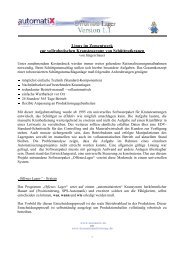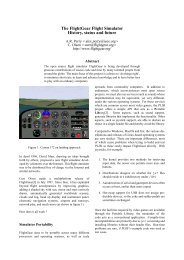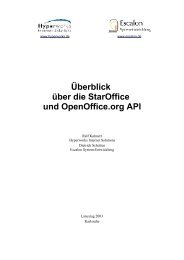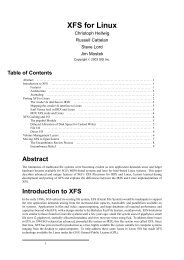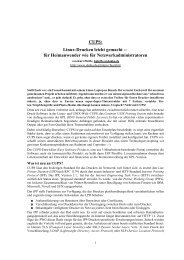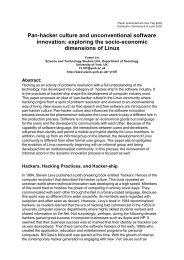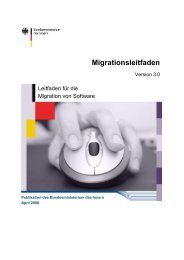Advanced Features of Linux strongSwan - the OpenSource VPN ...
Advanced Features of Linux strongSwan - the OpenSource VPN ...
Advanced Features of Linux strongSwan - the OpenSource VPN ...
Create successful ePaper yourself
Turn your PDF publications into a flip-book with our unique Google optimized e-Paper software.
Figure 1: Typical <strong>VPN</strong> scenario<br />
The second much more challenging scenario depicted in Figure 1 is remote access. So called<br />
” road warriors“, equipped with dynamical IP addresses assigned by <strong>the</strong>ir local Internet Service<br />
Providers (ISPs) are able to build up a <strong>VPN</strong> tunnel to <strong>the</strong> security gateway 11.22.33.44<br />
from any point <strong>of</strong> <strong>the</strong> Internet using ei<strong>the</strong>r fixed connections, public WLAN hot spots or mobile<br />
communication channels. Thus <strong>the</strong> remote access clients get full access to all resources<br />
in <strong>the</strong> 10.1.0.0/16 network as if <strong>the</strong>y were located right at Head Quarters.<br />
We will come back to <strong>the</strong> special properties <strong>of</strong> <strong>the</strong> road warrior case later in this paper and<br />
continue by first giving a short overview on <strong>the</strong> IPsec standard which basically consists <strong>of</strong><br />
two parts:<br />
• The actual encryption and au<strong>the</strong>ntication <strong>of</strong> tunneled IP packets takes place in <strong>the</strong><br />
kernel using <strong>the</strong> Encapsulating Security Payload (ESP) standard defined by RFC 2406.<br />
ESP is IP protocol 50 and doesn’t have ports.<br />
• The initial negotiation and <strong>the</strong> ensuing periodic re-keying <strong>of</strong> IPsec tunnels is done by<br />
a userland daemon running <strong>the</strong> Internet Key Exchange (IKE) protocol defined by RFCs<br />
2407, 2408, and 2409. IKE is transported over UDP datagrams and must use <strong>the</strong> wellknown<br />
source and destination port 500.<br />
1.1 The IPsec Kernel Part - ESP<br />
The ESP encapsulation <strong>of</strong> IP packets is shown in figure 2. Referring to <strong>the</strong> site-to-site <strong>VPN</strong><br />
scenario depicted in figure 1, a TCP packet exchanged between a host 10.1.0.5 in <strong>the</strong> 10.1.0.0/16<br />
network and a host 10.2.0.7 in <strong>the</strong> 10.2.0.0/16 network will carry <strong>the</strong>se two addresses as source<br />
and destination in <strong>the</strong> original IP header, whereas <strong>the</strong> outer IP header <strong>of</strong> <strong>the</strong> IPsec packet<br />
will contain <strong>the</strong> addresses 11.22.33.44 and 55.66.77.88 <strong>of</strong> <strong>the</strong> <strong>VPN</strong> gateways that do <strong>the</strong> actual<br />
tunneling. ESP encrypts <strong>the</strong> whole original IP packet including <strong>the</strong> internal header and secures<br />
<strong>the</strong> encrypted content against unauthorized modification by computing and appending<br />
a cryptographic checksum.





